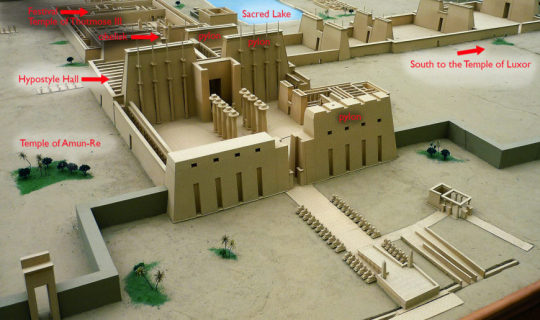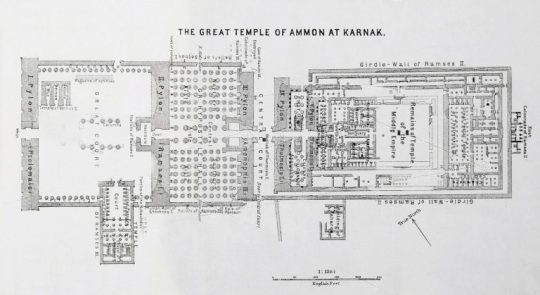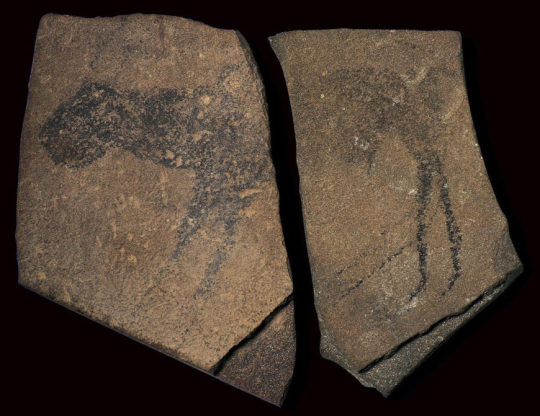Text
Temple of Amun-Re and Hypostyle Hall




Karnak, Egypt
New Kingdom Egypt (Ancient Near East)
1550 BCE (temple) 1250 BCE (hall)
Cut sandstone and mud brick
Form: Combining the land from all components of this site, it spans more than 200 acres. The sacred area enclosed to honor Amun is 61 acres all by itself, and the hypostyle hall is 54,000 square feet (making it the largest singular room of any religious building in the world to this day) and is filled with 134 columns. The inside of the temple was originally brightly painted
Content: Inside of the temple, the main path through the center slowly raises the deeper inside the building it gets. The columns inside the hall have shallow reliefs carved into them and depict creation stories, as well as symbols of paradise (lotus, palm plants, papyrus). The roof/ceiling would have been decorated with images of stars, the sky, and birds.
Context: In ancient Egypt, it was believed that at the end of agricultural season, the gods and earth were left exhausted. Because of this, it was necessary to help replenish their energy by participating in the Opet festival. The Opet festival lasted for 27 days, starting at the Temple of Amun-Re and the Hypostyle Hall, and ending 1 and a half miles south. This celebration also strengthened the link between a pharaoh and Amun. Accessibility to the deeper parts of the temple became more and more restrictive with each pylon (see image 2), as a means to show the higher social class was closer to god. However, the deepest part of the temple was restricted to priests and the pharaoh exclusively. The temple and hall were a pilgrimage site for over 2,000 years.
Function: While the religious ritual practices at this site serve as its main function, the temples also represented the creation of the world as the Egyptians believed it. It was believed that the world was originally only water, and that the first solid land to emerge from the water was a pyramid-like mound, also known as a benben. The structure of the temples were shaped in this way as well, so when the Nile flooded, it would seem even more like the original mound of creation.
sources:
khan academy
#ap art history#ancient mediterranean#ancient egypt#ritual#power and authority#sacred space#narrative#architecture#relief sculpture#temple of amun re#hypostyle hall
6 notes
·
View notes
Text
Apollo 11 Stones

Namibia (southern Africa)
African Prehistory
25,500 - 25,300 BCE
Charcoal on stone
Context: While this work's name might bring to mind outer space exploration, don’t let it fool you. These stones were named after the Apollo 11 spaceflight, but this is simply because the cave it was excavated from was discovered just before news spread of the moon landing.
Form: A single slab of stone split down the middle, a drawing is etched on them with charcoal. When the Stones were first excavated they had already been broken into their respective halves.
Content: The creature depicted on the rock(s) appears to be an animal of some kind. Some people think the figure is a therianthrope (an animal + human hybrid), while others think it's an abstract representation of a real animal. Because this work is from prehistory, there is little evidence to accurately determine what is being represented or what the Apollo Stones exact function was.
Function: One common theory is that the Apollo 11 Stones played a role in a ritual of some kind; this is due to other objects found in the same space during the dig. Another thought is that it could have served as a warning, essentially a sign saying "don't stay here. a freaky animal lives around here and is dangerous."
sources:
smarthistory
khan academy
1 note
·
View note
Text
hi. so i actually finished taking ap art history! my test date was in May of 2023. i originally wanted to make this blog for myself to study, but i started it too late. anyway! figured id share it for anyone else who might find it helpful when studying! (i'm probably gonna be slow to add to this btw, but so far we got 3/250 LOL)
**disclaimer: i am NOT an expert in art history and i cannot guarantee everything i say will be 100% accurate. with this in mind, i sure will try my best :,)**
How this Blog Works
each post will have the image(s) College Board provides for a piece and will contain in bold and italics: title, area of origin, culture, date the work was made, and a brief description of media used.
additionally, there will be a paragraph included explaining more in depth about a works form, function, content, and context.
each one of the 250 works will be marked with the following tags for easier navigation:
content area number
associated art movement
themes
religious/non-religious
painting/architecture/scultpure/photo/installation
also i will add a link to the khan academy article for each piece. and also any miscellaneous videos/resources that i think are worth checking out!
thanks for reading, hope this will be helpful to someone :]
3 notes
·
View notes